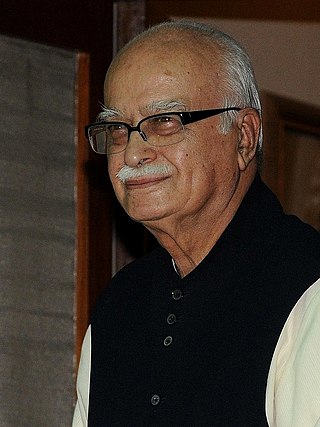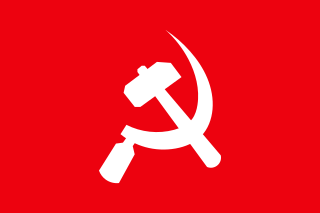Related Research Articles

The Indian National Congress (INC), colloquially the Congress Party or simply the Congress, is an Indian political party. Founded in 1885, it was the first modern nationalist movement to emerge in the British Empire in Asia and Africa. From the late 19th century, and especially after 1920, under the leadership of Mahatma Gandhi, the Congress became the principal leader of the Indian independence movement. The Congress led India to independence from the United Kingdom, and significantly influenced other anti-colonial nationalist movements in the British Empire.

Lal Krishna Advani is an Indian politician who served as the 7th Deputy Prime Minister of India from 2002 to 2004. Advani is one of the co-founders and a senior leader of the Bharatiya Janata Party. He is a long time member of the Rashtriya Swayamsevak Sangh, a volunteer organisation. He is also the longest serving Minister of Home Affairs in the BJP-led National Democratic Alliance government from 1998 to 2004. He was the Leader of the Opposition in the 10th Lok Sabha and 14th Lok Sabha and also the longest serving person of this post. He was the Prime Ministerial candidate of BJP in 2009.

The Nepali Congress is a social democratic political party in Nepal and the largest party in the country. The party has 870,106 members as of the party's 14th general convention in December 2021 making them the largest party by membership in Nepal.

Vishwanath Pratap Singh , shortened to V. P. Singh, was an Indian politician who was the 7th Prime Minister of India from 1989 to 1990 and the 41st Raja Bahadur of Manda. He is India's only prime minister to have been former royalty.

The Janata Party was a political party that was founded as an amalgam of Indian political parties opposed to the Emergency that was imposed between 1975 and 1977 by Prime Minister Indira Gandhi of the Indian National Congress. In the 1977 general election, the party defeated the Congress and Janata leader Morarji Desai became the first non-Congress prime minister in independent modern India's history.
Sikkim Janata Congress was a political party in Sikkim, active in the struggle for democratic reforms. SJC was founded when the Sikkim State Congress and Sikkim Janata Party merged, in October 1972. K.C.Pradhan was it’s President.
The Sikkim State Congress, or SSC, was an annexationist political party in the Kingdom of Sikkim. It was founded in 1947 and worked closely with the Indian National Congress (INC) to successfully achieve the annexation of Sikkim to India. Other parties established by the INC to serve India's interests in its near abroad included the Nepal State Congress Party and the Bhutan State Congress Party.
Sikkim Sangram Parishad is a regional political party in the Indian state of Sikkim. In 1979, after a period of instability, a ministry headed by Nar Bahadur Bhandari from Sikkim Janata Parishad party gained power in Sikkim. In 1984, Bhandari dissolved Sikkim Janata Parishad and formed a new party called Sikkim Sangram Parishad. Sikkim Sangram Parishad held on to power in the 1984 and 1989 elections, but after that lost to Sikkim Democratic Front, which has swept the elections since 1999. Sikkim Sangram Parishad did not win any seats in the state assembly in the 2004 elections. Nar Bahadur Bhandari has merged Sikkim Sangram Parishad with the Indian National Congress and he became the president of the Sikkim Pradesh Congress Committee (SPCC).

Malhara Assembly constituency is one of the 230 Vidhan Sabha constituencies of Madhya Pradesh state in central India. This constituency came into existence in 1951, as one of the 48 Vidhan Sabha constituencies of the erstwhile Vindhya Pradesh state, but it was abolished in 1956. It again came into existence in 1961, following delimitation of the legislative assembly constituencies.
Lal Bahadur Basnet was a politician and a leader of the Pro-Democracy Movement in the erstwhile Himalayan Kingdom of Sikkim.
General elections were held in Sikkim in May 1953. The Sikkim National Party and the Sikkim State Congress both won six seats. Voter turnout was less than 30%.

The Nepal Praja Parishad was the first attempt to form an organization to lead the revolution against the Rana dynasty in Nepal. Led by Tanka Prasad Acharya, the group was founded in 1936, and is seen as the first political party in Nepal. The organisation collapsed after their plot to assassinate multiple members of the Rana regime was discovered, and some of its key members were executed.

Sikkim Krantikari Morcha is a political party in the Indian state of Sikkim which is the ruling party of Sikkim since 2019.
Bhim Bahadur Gurung was the third Chief Minister of Sikkim. He held office from 11 May until 24 May 1984, the shortest term in the history of Sikkim.
Nar Bahadur Khatiwada is a politician and lawyer from Sikkim.
General elections were held in Sikkim in January 1973. The Sikkim National Party emerged as the largest party, winning nine of the 18 elected seats.
Gangtok Assembly constituency is one of the 32 assembly constituencies of Sikkim a north east state of India. Gangtok is part of Sikkim Lok Sabha constituency. This Constituency is Scheduled Tribe constituency from 2009.

Communism in Nepal traces its roots back to the pro-democracy movement of 1951, and the subsequent overthrow of the autocratic Rana regime and the establishment of democracy in Nepal. The communist movement in Nepal has split into factions multiple times and multiple factions have come together into a single fold at times as well. It has a history of getting banned from open political discourse, as well as multiple instances of embracing guerrilla insurgency, most notably, the Maoist insurgency in the 1990s and early 2000s that led to the Nepalese Civil War, claiming at least 17,000 lives.

Nahakul Pradhan also known as Nakul Pradhan was a Sikkimese pre-merger politician, pro-democracy leader, a member of the Sikkim State Council and Executive Council of Sikkim serving multiple terms. He was the President of the Sikkim State Congress party and the Editor of Sikkim’s first news magazine Kanchenjunga.

The State Council of Sikkim was the legislative body of the erstwhile Kingdom of Sikkim, which was located in the Himalayas, between India and China.
References
- 1 2 3 4 Satyendra R. Shukla (1976). Sikkim: The Story of Integration. S. Chand. pp. 77, 82, 223. ISBN 978-0-8426-0872-5. OCLC 164804020.
- 1 2 Himmat, Volume 6, Issues 1-25. R.M. Lala. 1969. p. 1. OCLC 1774357.
A new political party called the Sikkim Janata Party emerged in Sikkim and it's [sic] president, Lal Bahadur Basnet, said that it's [sic] aim is socialism.
- 1 2 Nirmalananda Sengupta (1985). State Government and Politics, Sikkim. Sterling. pp. 87, 163. ISBN 978-0-86590-694-5. OCLC 12978086.
- 1 2 3 4 5 Hamlet Bareh, ed. (2001). Encyclopaedia of North-East India: Sikkim. Mittal Publications. pp. 107–108. ISBN 9788170997948. OCLC 1285484126.
- ↑ Lal Bahadur Basnet (1974). Sikkim: A Short Political History. S. Chand. p. 153. ISBN 978-0-8426-0627-1. OCLC 1043995922.
- ↑ Nepal Press Report, Issues 500-593. Regmi Research Project. 1971. p. 10. OCLC 6109752.[ failed verification ]
- 1 2 Awadhesh Coomar Sinha (1975). Politics of Sikkim: A Sociological Study. Thomson Press (India), Publication Division. p. 86. OCLC 1933932.
- ↑ Aparna Bhattacharya (1992). The Prayer-wheel & Sceptre, Sikkim. Nachiketa Publications. p. 146. OCLC 32892911.
- ↑ Syed Amanur Rahman; Balraj Verma, eds. (2006). The Beautiful India - Sikkim. Reference Press. p. 334. ISBN 9788184050196. OCLC 154689593.
- ↑ Jigme N. Kazi (20 October 2020). Sons of Sikkim: The Rise and Fall of the Namgyal Dynasty of Sikkim. Notion Press. ISBN 978-1-64805-981-0.
- ↑ Asia Yearbook. Far Eastern Economic Review Limited. 1971. p. 281. OCLC 1791821.
- ↑ Sikkim Herald, Volume 11, Issues 1-100. Sikkim Publicity Department. 1970. OCLC 1714501.
- ↑ B. S. K. Grover (1974). Sikkim and India: Storm and Consolidation. Jain Bros. p. 59. OCLC 1063130178.
- ↑ Ramananda Chatterjee, ed. (1970). The Modern Review, Volume 127. Modern Review Office. p. 195. OCLC 1681145.
- 1 2 News Review on South Asia. The Institute. 1972. pp. 69, 157. OCLC 1753214.